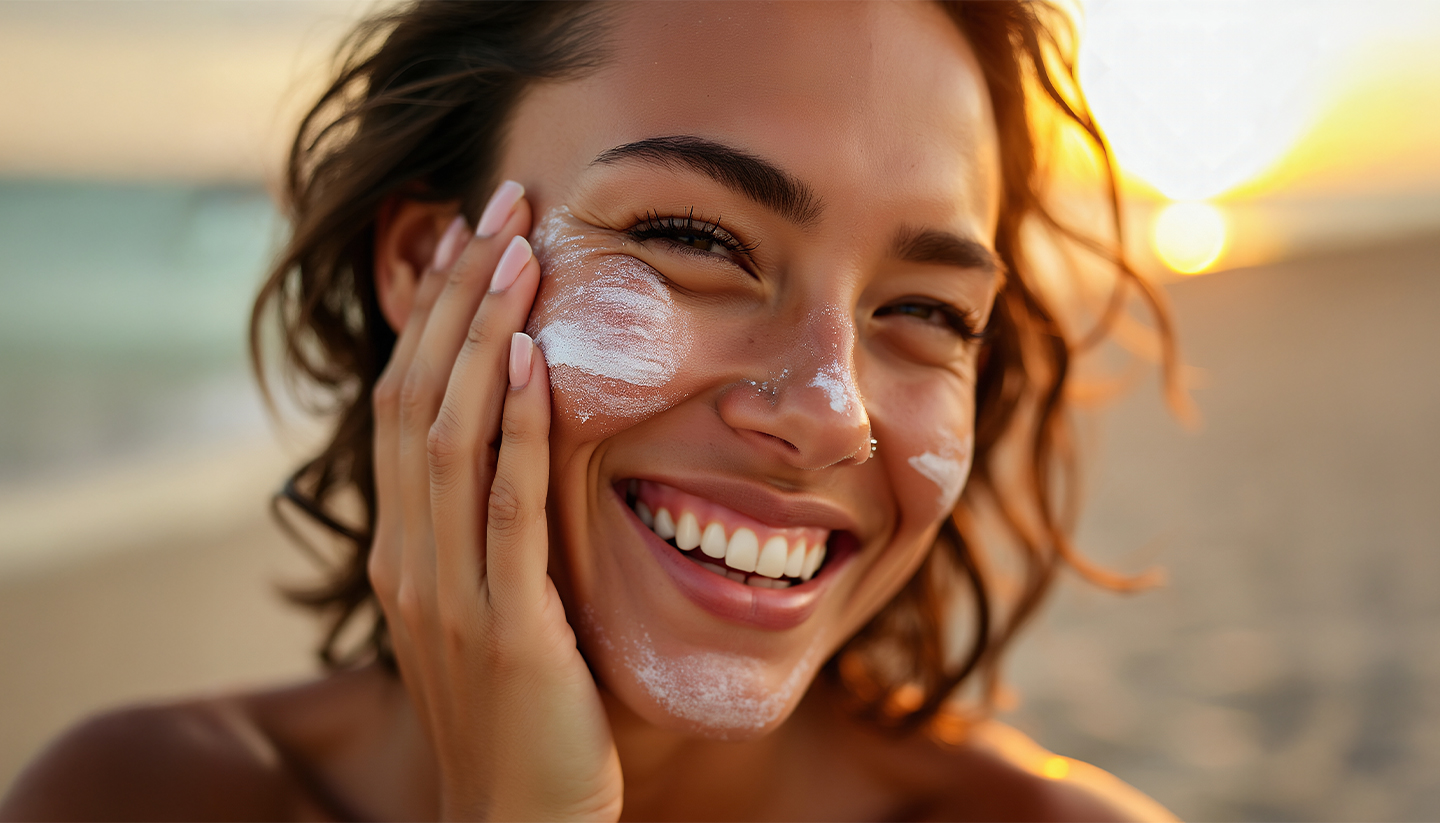In vitro evaluation of potential sun protection by eye drops
OLGA V DUEVA-KOGANOV*, MICHAEL KOGANOV ARTYOM DUEV
*Corresponding author
Intellebio, LLC, White Plains, NY, USA
ABSTRACT:Excessive sunlight exposure, especially its ultraviolet component, can cause or worsen disorders of the eye. Conventional eye protection often allows exposure by non-lens pathways, especially for ultraviolet. Sun-protective eye drops help protect the eye where conventional means are inadequate. Commercial eye drops with sun protective claims are rare. No published methods for measuring their effectiveness were found. An expedient spectrophotometric in vitro method was developed to assess maximum theoretical sun-protective potential from a single drop instillation of eye drop formulation. Two commercial benchmark eye drops were tested, their limited ability to block sunlight in ultraviolet B, ultraviolet A, and visible violet/blue wavelength ranges was calculated. Potential use of the method for developing better eye drops is discussed.
Introduction
??????????????????
“
“A study in healthy women providing probiotic yogurt for four weeks showed an improvement in emotional responses as measured by brain scans”
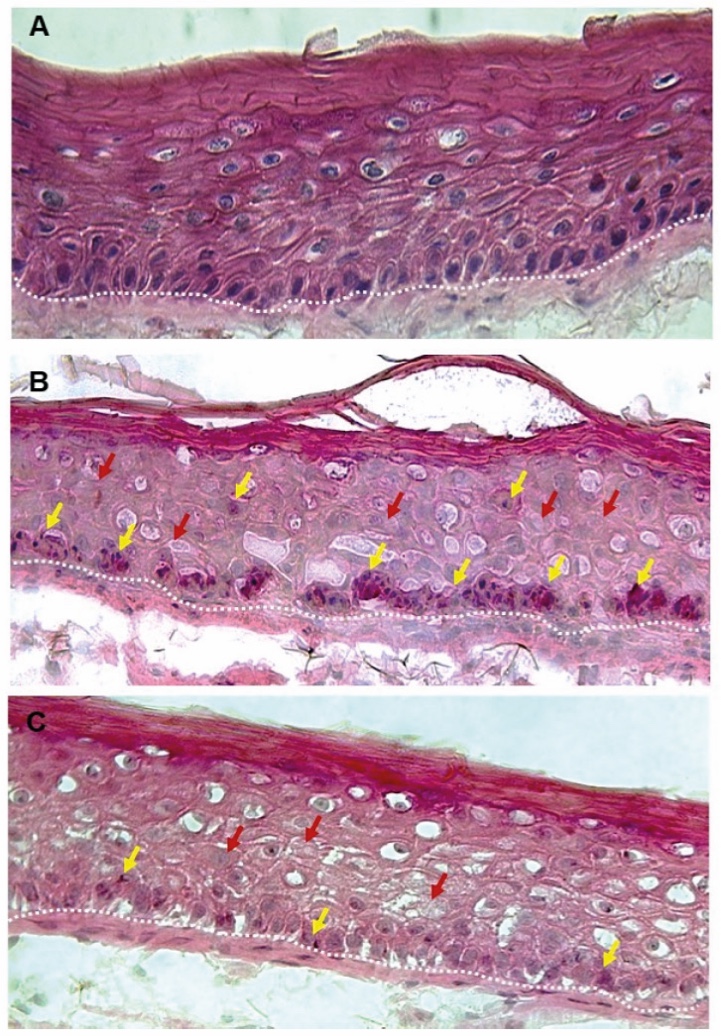
Figure 1. Skin Section with Microbiome. Most microorganisms live in the superficial layers of the stratum corneum and in the upper parts of the hair follicles. Some reside in the deeper areas of the hair follicles and are beyond the reach of ordinary disinfection procedures. There bacteria are a reservoir for recolonization after the surface bacteria are removed.
Materials and methods
Studies of major depressive disorder have been correlated with reduced Lactobacillus and Bifidobacteria and symptom severity has been correlated to changes in Firmicutes, Actinobacteria, and Bacteriodes. Gut microbiota that contain more butyrate producers have been correlated with improved quality of life (1).
A study in healthy women providing probiotic yogurt for four weeks showed an improvement in emotional responses as measured by brain scans (2). A subsequent study by Mohammadi et al. (3) investigated the impacts of probiotic yogurt and probiotic capsules over 6 weeks and found a significant improvement in depression-anxiety-stress scores in subjects taking the specific strains of probiotics contained in the yogurt or capsules. Other studies with probiotics have indicated improvements in depression scores, anxiety, postpartum depression and mood rating in an elderly population (4-7).
Other studies have indicated a benefit of probiotic supplementation in alleviating symptoms of stress. In particular, researchers have looked at stress in students as they prepared for exams, while also evaluating other health indicators such as flu and cold symptoms (1). In healthy people, there is an indication that probiotic supplementation may help to maintain memory function under conditions of acute stress.
The sun emits a constant stream of energy. According to CIE (Commission Internationale de l’Eclairage) the spectral distribution of natural solar radiation at Earth surface contains ~ 7% of Ultraviolet light - UV that includes UVB (280-320 nm) and UVA (320-400 nm), ~ 55% of Visible light – VIS (400-780 nm) and ~ 40% Infrared – IR (780 nm-1 mm).
Besides the skin, the eye is the organ most susceptible to sun-induced damage (1).
Excessive and cumulative sunlight exposure has been described as a cause, risk factor, or aggravating factor in pathogenesis of many ocular conditions. Short wavelength UV radiation has the highest potential for damage to the eye. For example, UVB at 300 nm is roughly 600 times more biologically effective at damaging ocular tissue than UVA at 325 nm (2). UVB radiation, with its higher energy, primarily affects the cornea and can cause acute conditions like photokeratitis or "snow blindness" (3). Cumulative effects of UVB are also possible (4). The full depth of atmosphere blocks radiation in 280 – 290 nm range strongly. Sensitive instruments can detect 280 – 290 nm UVB radiation from the Sun at Earth surface, but usually studies of health effects of solar UVB start at 290 nm. UVA, while less energetic, is more abundant and can damage the lens and cornea over time through oxidative stress mechanisms (3). The effect of High Energy Visible radiation - HEV (400 - 450 nm), or violet/blue light on eyes is also becoming a concern (5). Research suggests this involves oxidative stress generated via opsin pigments in retina (6).
Therefore, protecting the eye from both acute and chronic harm by sunlight is important.
The cornea and the intraocular lens are the most important ocular tissues for absorbing UV radiation. The cornea absorbs most of UVB radiation shorter than 300 nm and the lens primarily absorb UVA radiation shorter than 370 nm (7). Attenuation of the UV radiation at the anterior ocular surface is the main way to prevent its absorption by ocular tissues, thus reducing the risk of some sunlight-related eye diseases. The most common forms of ophthalmic attenuators of UV radiation are sun glasses and contact lenses (8).
Invasive methods like implanted intraocular lenses also exist.
UV radiation is incident at the ocular surface either after transmittance through the sunglass lens itself, or by being obliquely incident around the edge of the sunglass lens.
This oblique incidence is termed a non-lens pathway. Thus, the eye can be exposed to UV radiation from the side - laterally, behind - light is reflected off the back surface of the lens and into the eye and below, leaving the lateral cornea and conjunctiva exposed (9).
Many sunglass designs give poor side protection allowing UV rays to enter the eye from the side (10).
A study showed that even with outer surfaces of prescription glass lenses completely covered by opaque black tape, over 6% of incident UV radiation still reached the eye via reflections (11). Anti-glare or anti-reflective coating is a common convenient feature for glasses. It works well against visible light, but can reflect UV (12). Such reflections can allow more of unmitigated UV radiation to reach the eye.
Intended attenuation of sunlight by sunglass lenses, and unintended “non-lens” paths of sunlight are shown in Figure 1.
The shadow seen through the glasses shows unmitigated sunlight coming near the eye.
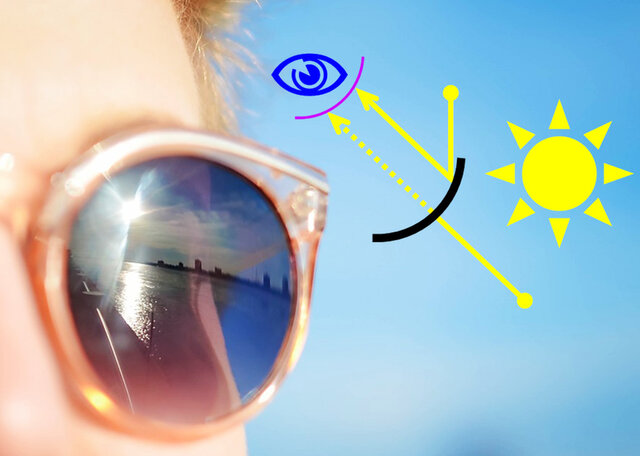
Figure 1. Mitigated and unmitigated sunlight reaching the eye by different paths.
While wrap-around or goggle-like designs for sunglasses protect better, people may still choose inadequately protective designs for aesthetic reasons.
This demonstrates that while conventional measures like sunglasses or a wide-brimmed hat help, they do not provide thorough enough protection.
Some authors recommend UV-blocking contact lenses to improve total protection (13). However, prolonged use of contact lenses can lead to papillary conjunctivitis, subclinical inflammation, and increase in mechanical sensitivity (14).
In professions involving hazardous or irritating materials, contact lenses could trap these materials and increase the risk of harm to eye.
Arguably, more comprehensive sun protection could be achieved by using sun-protective eye drops together with hats and sunglasses.
For example, sun-protective eye drops could further attenuate harmful light filtered by sunglasses, and provide some mitigation of light from non-lens pathways.
This could be valuable for people whose eyes are more easily harmed by light (e.g. after cataract surgery) or people exposed to unusual amounts of light (e.g. people living at higher altitudes or nearer equator, skiers, surfers, desert travelers).
Presently, there are few commercially available eye drops with UV or sun protection claims. Literature search found no relevant in vitro methods for testing efficacy of sun-protective eye drops.
Therefore, we developed an in vitro method to evaluate the potential sun protection efficacy of eye drops.
Commercially available benchmarks were tested using the developed method.
Background
UV-VIS spectrophotometry is commonly used to develop products that protect from light, like sunscreen or welder’s goggles. Appropriate measurement parameters and portable modular equipment were selected for evaluating sun-protective eye drops.
A key parameter for characterizing the material using transmitted light is the path length, or thickness of material, through which light passes.
For measuring performance of eye drops in identical reasonable conditions, a liquid layer of appropriate thickness can be made by a single eye drop instillation spread over area comparable to exposed human eyeball surface.
Ophthalmic solutions are available for multidose or single-dose administration in a wide variety of glass and plastic dropper bottles which deliver drops with a volume between 25 and 70 microliters (0.025-0.07 ml) (15).
Thus, 40 microliter (0.04 ml) is a reasonable volume for a single eye drop instillation.
For both men and women, the mean surface area of eyeball exposed to external factors in the working environment is about 1.72 - 1.82 cm2(16).
Thus, 2 cm2 is reasonably like exposed human eyeball area.
Relating spectrophotometric measurements to health effects involves the concept of “action spectrum”.
It is relative efficacy of different wavelengths of light at causing an effect.
For example, photosynthesis in land plants is powered by red and blue light, not green light; human night vision relies on response of rod cells in retina to blue-green light, but not red light. This also applies to wavelengths outside visible light range, like UV or IR.
Different ways that light – including UV and IR – can harm people have different action spectra.
Describing an action spectrum in terms of broad wavelength ranges is a common practical simplification.
Graphical explanation of spectrophotometry and action spectra relevant to the developed method is in Figure 2.
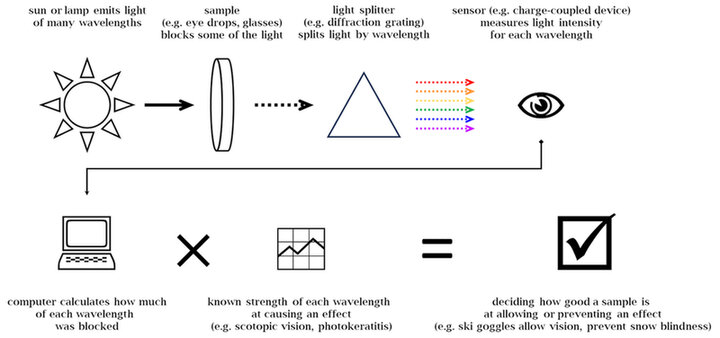
Figure 2. Spectrophotometry and action spectra as applicable to developed method.
Equipment:
-SILVER-Nova Compact research grade spectrometer for 190-1110 nm range with thermoelectrically cooled CCD detector; SL3 deuterium light source; SL1 tungsten halogen light source; vertical transmittance fixture (all from StellarNet Inc., Tampa, FL, USA);
-Type 42 demountable disc-shaped circular dichroism quartz cuvettes with light path 0.2 mm, outer diameter 22 mm; inner diameter 16 mm; capacity 0.04 ml (from FireflySci, Inc., Northport, NY, USA).
Commercial benchmarks
Product A - Drop Defence® Anti UV Eye Drops Lot 011 22/A, Expiration date May 2025.
Package labeling states that it is an anti-UV ophthalmic protective solution containing Riboflavin sodium phosphate 0.05%, Vitamin E TPGS, MSM, amino acids and Hyaluronic Acid.
Manufacturer further describes Drop Defence® as “unique and certified Personal Protective Equipment that protects cornea, crystalline lens and retina against UV radiation, blue light, artificial light sources, and prolonged sun exposure, preventing damages like photo-keratitis, photo-keratoconjunctivitis, cataract and AMD” while keeping “the ocular surface hydrated and protected” (17).
Product B - Refresh Optive® Advanced Lubricant Eye Drops Lot 392525, Expiration date November 2024.
Package labeling lists active ingredients: Carboxymethylcellulose Sodium 0.5%, Glycerin 1%, Polysorbate 80 0.5%; and inactive ingredients: boric acid, carbomer copolymer type A, castor oil, erythritol, levocarnitine, purified water, stabilized oxychloro complex.
Manufacturer describes this formulation as “recommended for the temporary relief of burning, irritation, and discomfort due to dryness of the eye or exposure to wind and sun” (18).
Experimental
An in vitro method was developed to assess maximum theoretical sun-protective potential from a single drop instillation of eye drop formulation.
The absorbance spectra of the undiluted test article were recorded in circular quartz cuvettes with surface area 2 cm2 approximating the exposed human eyeball area and path length 0.2 mm, holding 0.04 ml of liquid.
These conditions are like average eye drop volume instilled in the eye.
Distilled water was used as a reference – for calculations, measurements of distilled water were treated as unblocked light.
Spectrometer settings included integration time of 60 milliseconds and averaging of 5 measurements, active temperature compensation.
Detector was actively cooled.
Absorbance spectra of undiluted test articles are shown in Graph 1.
Note that higher absorbance means more blocked light.
Absorbance is calculated as negative base-10 logarithm of fraction of transmitted light.
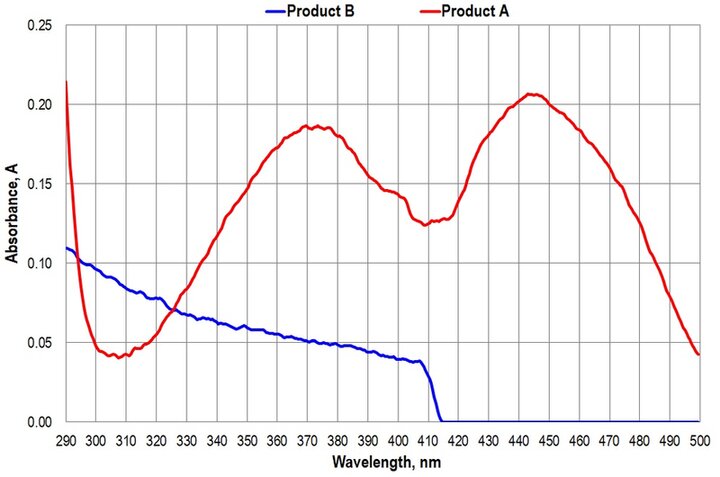
Graph 1. Absorbance spectra of Product A and Product B in UVB-UVA-HEV region.
Estimated percent sunlight that could be blocked by the test articles in the UVB, UVA and HEV ranges was calculated via equation shown in Figure 3 with parameters from Table 1.
Sunlight data was US Government standard reference for sunlight at Earth surface for airmass 1.5 (19).
Results of calculations are shown in Table 2 below.

Figure 3. Estimating percentage of blocked sunlight for a spectral range from absorption data.

Table 1. Wavelengths of relevant spectral ranges.
Disscussion and conclusion
It is well-known that due to blinking and dilution by tears, the whole instilled volume does not remain on the surface of the eye for long.
The developed in vitro method shows theoretical maximum protection as a tool for initial comparison of eye drop formulations, and a starting point for further development.
Simple method refinements like shorter path lengths or dilution with artificial tears are feasible.
More valuable are the conceivable formulations whose in vivo protection is retained for longer time, e.g. because active ingredients temporarily adsorb to cornea.
The maximum theoretical protection potential of eye drop benchmarks was determined in vitro under conditions mimicking immediate instillation of a single eye drop. The benchmarks demonstrated their protective effects against solar radiation, e.g. UVB, UVA and HEV. The results are given in Table 2.

Table 2. Estimated absorption of sunlight by benchmark eye drops.
Product A mainly absorbs UVA and HEV radiation. The shape of absorbance spectrum is like the characteristic absorbance of riboflavin, suggesting this protection mainly comes from Riboflavin sodium phosphate 0.05%. It should be noted that Riboflavin is not a photostable molecule (20). Thus, the formulation is likely to be sensitive to storage conditions, especially unmitigated light. Also, under certain conditions of use the formulation could act as photosensitizer (21). This may merit caution.
Product B mainly absorbs UVB and UVA radiation. The shape of the absorbance spectrum suggests it is likely due to a nonspecific mechanism like scattering by emulsified droplets of castor oil rather than specific absorption by dissolved ingredients. This may be due to turbidity at UV wavelengths.
The developed in vitro method for the evaluation of eye drop’s attenuation in UV-HEV range could be used for development and assessment of novel eye drops protective potential, especially against the most dangerous UVB portion of sunlight.
For example, the ophthalmic compositions described inSoroudi US 11,369,812 (22) utilizing various sunscreen actives are good candidates for evaluation via the developed in vitro method.
As the equipment used in the method is portable and modular, instead of dedicated light source modules it can use real indirect sunlight in different conditions, e.g. clear sky, cloudy sky, or in shadow. This may allow evaluating protection potential of eye drops in more realistic conditions.
Given validated and accepted numerical values of action spectra for specific eye disorders and diseases (e.g. cataract, photokeratitis, photoconjunctivitis, pterygium, retinal degeneration) this novel in vitro method could provide more specific estimates of protection for eyes via eye drops.
This approach may be like current practices for developing sun-protective products for skin.
Ultimately, eye drops created with help of the developed in vitro method could provide comprehensive UV protection, especially when combined with conventional means.
Conclusion
The future of cosmetics lies in the continued evolution of holistic approaches which represents a transformative shift in the industry, merging scientific advancements, natural ingredients, and wellness principles. By understanding and embracing the interconnectedness of these elements, the cosmetics industry can cultivate products that not only enhance external beauty but also contribute to the overall well-being of individuals and the planet.
The interplay between beauty from within and topical cosmetics is the key for future products. The integration of biotechnology and green chemistry is revolutionizing cosmetic formulations, offering sustainable and biocompatible alternatives.
Developers can implement blockchain to trace the journey of ingredients from source to product. Nevertheless, the efficacy of the natural products should be scientifically proven. Marketers can communicate transparency as a brand value, and parallelly educate consumers by highlighting how specific ingredients contribute to radiant and healthy skin.
By embracing the synergy between these approaches and leveraging scientific advancements, the cosmetics industry can provide consumers with comprehensive beauty solutions that cater to both internal and external dimensions of beauty.
Surfactant Applications
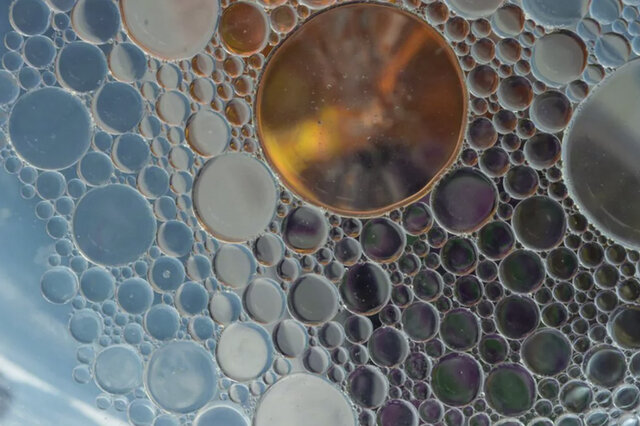
The application area lends itself particularly well to the use of AI. Active today in this area is the US company Potion AI (6). The company provides AI-powered formulation tools for beauty and personal care R&D. Their offerings include Potion GPT, next generation ingredient and formula databases and AI document processing. Potion’s work could have a significant impact on the entire surfactant value chain, from raw material suppliers to end consumers. By using their GPT technology, they can help target work toward novel surfactant molecules that have optimal properties for specific applications. By using their ingredient and formula databases, they can access and analyze a vast amount of data on surfactant performance, safety, and sustainability. By using their AI document processing, they can extract and organize relevant information from patents, scientific papers, and regulatory documents. These capabilities could enable Potion AI's customers to design and optimize surfactant formulations that are more effective, eco-friendly, and cost-efficient. A particularly interesting application for this type of capability is deformulation.
Deformulation is the process of reverse engineering a product's formulation by identifying and quantifying its ingredients. Deformulation can be used for various purposes, such as quality control, competitive analysis, patent infringement, or product improvement. However, deformulation can be challenging, time-consuming, and costly, as it requires sophisticated analytical techniques, expert knowledge, and access to large databases of ingredients and formulas.
AI can potentially enhance and simplify the deformulation process by using data-driven methods to infer the composition and structure of a product from its properties and performance. For example, AI can use machine learning to learn the relationships between ingredients and their effects on the product's characteristics, such as color, texture, fragrance, stability, or efficacy. AI can also use natural language processing to extract and analyze information from various sources, such as labels, patents, literature, or online reviews, to identify the possible ingredients and their concentrations in a product.
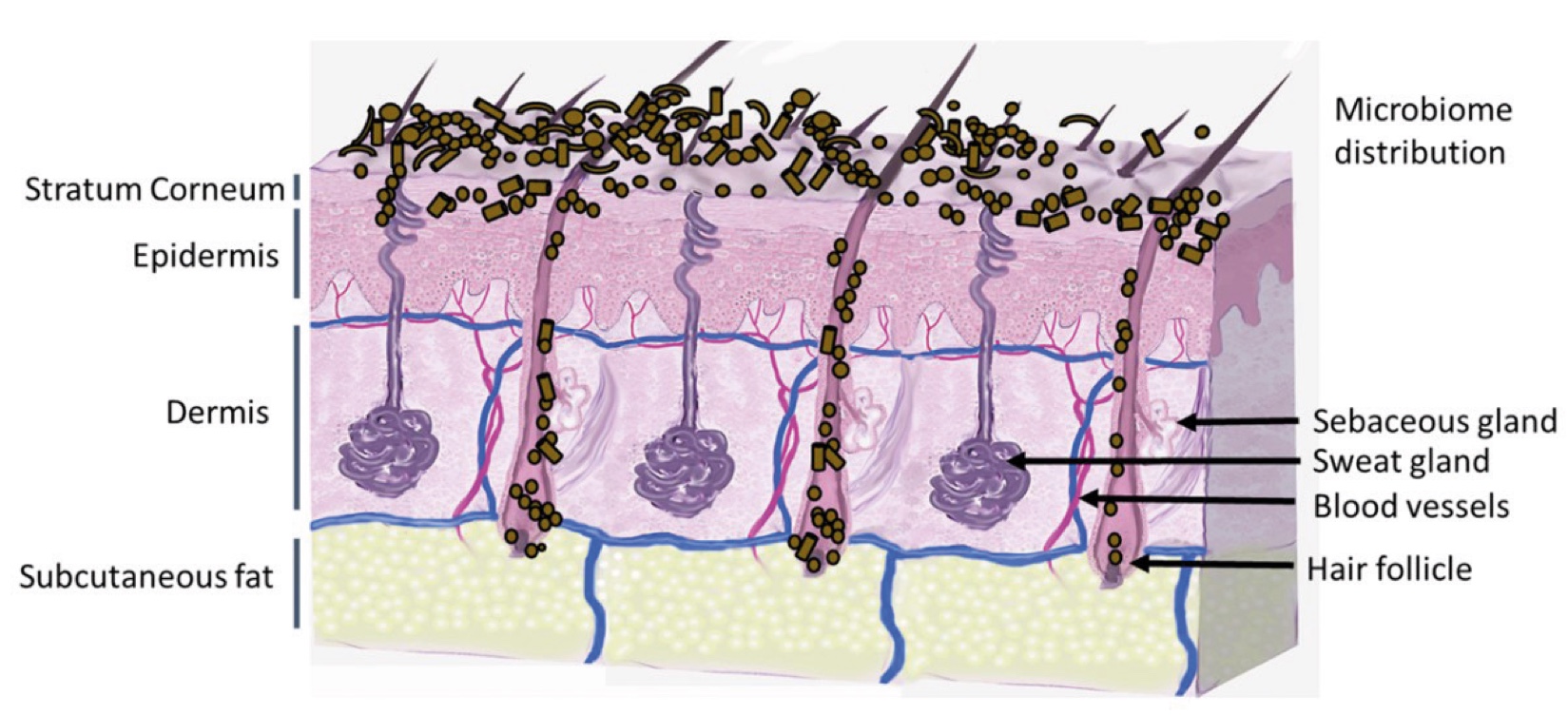
Figure 2. Skin Section with Microbiome. Most microorganisms live in the superficial layers of the stratum corneum and in the upper parts of the hair follicles. Some reside in the deeper areas of the hair follicles and are beyond the reach of ordinary disinfection procedures. There bacteria are a reservoir for recolonization after the surface bacteria are removed.
References and notes
- Roberts J. Ocular phototoxicity. J Photochem Photobiol B, 2001; 64:136-43. https://www.sciencedirect.com/science/article/abs/pii/S1011134401001968
- Young A. Acute effects of UVR on human eyes and skin. Prog Biophys Mol Biol. 2006; 92:80-5. https://pubmed.ncbi.nlm.nih.gov/16600340/
- Wittenberg S. Solar radiation and the eye: a review of knowledge relevant to eye care. Am J Optom Physiol Opt. 1986; 63(8):676-8. https://pubmed.ncbi.nlm.nih.gov/3532811/
- Delic N, Lyons J, Di Girolamo N, Halliday. Damaging Effects of Ultraviolet Radiation on the Cornea. Photochem Photobiol. 2017; 93:920-929. https://pubmed.ncbi.nlm.nih.gov/27935054/
- Zhao ZC, Zhou Y, Tan G, Li J. Research progress about the effect and prevention of blue light on eyes. Int J Ophthalmol. 2018; 11(12):1999-2003. https://pubmed.ncbi.nlm.nih.gov/30588436/
- Organisciak D, Vaughan D. Retinal light damage: Mechanisms and protection. Progress in Retinal and Eye Research. 2010; 29 (2):113- 134. https://www.sciencedirect.com/science/article/abs/pii/S1350946209000731
- Longstretch J et al. Health risks. J Photochem Photobiol B. 1998; 46:20-39. https://www.sciencedirect.com/science/article/abs/pii/S1011134498001833
- Sliney D. UV radiation ocular exposure dosimetry. Doc Ophthalmol. 1995; 88: 243-254. https://link.springer.com/article/10.1007/BF01203678
- Moore LA et.al. Review of photokeratitis: Corneal response to ultraviolet radiation (UVR) exposure. S Afr Optom. 2010; 69(3):123-131. https://avehjournal.org/index.php/aveh/article/view/137
- Sliney D. Epidemiological studies of sunlight and cataract: the critical factor of ultraviolet exposure geometry. Ophthalmic Epidemiol. 1994; 1:107-119. https://pubmed.ncbi.nlm.nih.gov/8790617/
- Rosenthal F, Bakalian A, Taylor H. The Effect of Prescription Eyewear on Ocular Exposure to Ultraviolet Radiation. AJPH. 1986; 76 (10): 1216-1220. https://ajph.aphapublications.org/doi/epdf/10.2105/AJPH.76.10.1216
- Citek K. Anti-reflective coatings reflect ultraviolet radiation. Optometry - Journal of the American Optometric Association. 2008; 79 (3):143-148. https://www.sciencedirect.com/science/article/abs/pii/S1529183907005775
- Walsh K. UV radiation and the Eye. Optician. 2009; 237; 6204: 26-33. https://www.jnjvisioncare.ae/sites/default/files/public/tvci_uv_radiation_and_the_eye.pdf
- Morgan P et al. CLEAR - Effect of contact lens materials and designs on the anatomy and physiology of the eye. Cont Lens Anterior Eye. 2021; 44(2):192-219. https://pubmed.ncbi.nlm.nih.gov/33775377/
- Santvliet LV, Ludwig A. Determinants of eye drop size. Surv Ophthalmol. 2004; 49(2):197–213. https://www.sciencedirect.com/science/article/abs/pii/S0039625703001838
- Juliszewski T, Kadłuczka F, Kiełbasa P. Determining eyeball surface area directly exposed to the effects of external factors. Int J Occup Saf Ergon. 2016; 22 (2): 279-282. https://pubmed.ncbi.nlm.nih.gov/26758027/
- https://servimed-industrial.com/wp-content/uploads/DROP-defence-Brochure-2021-eng_web.pdf
- https://www.refresheyedrops.com/products/refresh-optive-advanced
- Standard Airmass 1.5 (AM 1.5) Solar Irradiance, Watts per Square Meter per nanometer, ASTM G173-03 Reference Spectra (Direct + circumsolar W * m-2 * nm-1) https://www.nrel.gov/grid/solar-resource/spectra-am1.5.html
- Sheraz MA, Kazi SH, Ahmed S, Anwar Z, Ahmad I. Photo, thermal and chemical degradation of riboflavin. Beilstein J Org Chem. 2014; 10 (8):1999-2012. https://pubmed.ncbi.nlm.nih.gov/25246959/
- Cardoso DR, Libardi SH, Skibsted LH. Riboflavin as a photosensitizer. Effects on human health and food quality. Food Funct. 2012; 3(5):487-502. https://pubmed.ncbi.nlm.nih.gov/22406738/
- Soroudi AE. Non-irritating, non-blurring ophthalmic sunscreen. US 11,369,812.
- https://patents.google.com/patent/US11369812B2/en
